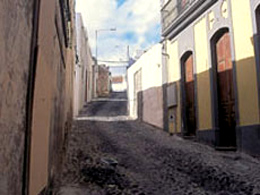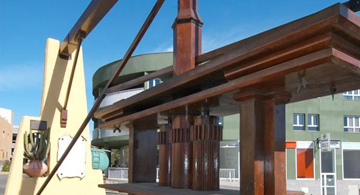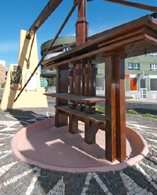The fiesta in honour of the Patron Saint of Ingenio is celebrated in the first week of February in the town centre. This is the Fiesta of Nuestra Señora de la Candelaria. During this fiesta, all the locals gather for a pilgrimage-offering to the Virgin, accompanied by folklore shows and livestock fairs. The pilgrimage finishes with the popular Taifas Ball, with music from several folklore groups.
Other characteristic celebrations in the borough are the Fiestas of Nuestra Señora del Buen Suceso, in the town of de El Carrizal, where they organise another very popular pilgrimage.
‘La Bajá del Macho’ is another popular festival in the borough, held in October. It commemorates the election of the best male goat in the Pasadilla Fair. The chosen goat is feted in the procession that follows.
There are other festivities such as the fiestas of San Pedro and San Pablo (Saint Peter and Saint Paul) in the month of June, as well as those of San Isidro and San Roque in Carrizal.
During the colonisation of Gran Canaria and the share out of lands among the leaders of the conquest, the Agüimes estate became part of the church estate. This land was characterised by its extensive arable land on either side of the Guayadeque Ravine, irrigated by the springs from the ravine.


On the left edge of Guayadeque was the Ingenio estate, where sugar cane was grown at the initiative of the Portuguese settlers who came to the island. Alonso de Matos, a Portuguese merchant, built the first sugar mill in the Aguatona Valley.
Most of the local families started to settle around this industrial complex. By the mid 16th century, this growth in the population led to the construction of a chapel, the predecessor of the present Church of La Candelaria.
The agricultural development of the area increased the population of the town even further in the 16th and 17th centuries. But, at the end of the 17th century, and due to the fact that the natural resources of Ingenio were unable to support so many people, people started to migrate away from the main settlements.
In the 19th century, Ingenio won independence from the Town of Agüimes and became a municipal entity, once the ecclesiastical authorities granted authorisation, and the small chapel of La Candelaria was declared an independent parish church in 1815.
Ingenio is situated in the South-East of the island of Gran Canaria, covering an area of 38 square kilometres, set on a slope at 1,200 metres above sea level at its highest point, at the Caldera de Los Marteles, down to 310 metres above sea level in the centre of Ingenio. The borough of Ingenio is triangular in shape, with the sides running along the El Draguillo Ravine, to the north, marking the boundary between Ingenio and the borough of Telde, and to the south, the Guayadeque Ravine, which marks the boundary with the District of Agüimes.
The gentle slope on which the borough is set runs down to sea, with a more prominent part in the area of the Guayadeque Ravine. This ramp is made up of basalt material in the form of lava flows and mantles of pyroclasts, which is interrupted by a broad alluvial plain just a few metres before reaching the coastal area of the borough.
The coast of the borough stretches along three kilometres, that are predominated by an absence of cliffs and breaks in the shoreline.
From the 16th century, the economic activity of the borough revolved around the industrial activity generated by sugar cane. The popular sugar “ingenio”, or mill, that was built in the area became the reference point of the borough and the name of the borough comes from this. So, Ingenio became an important economic estate for several centuries.


But sugar cane is no longer grown in Ingenio, because the sugar cane grown on a much larger scale in the Americas was cheaper than the Canary Island produce, although the quality was inferior. In the 17th century, this triggered the sugar cane crisis in Gran Canaria.
Even so, Ingenio is still a borough in which most of the population works in the agricultural sector, and there is a growth in the services sector in the town centre.
Ingenio is also a leading craft centre on the island, specialising in calado canario (typical Canarian openwork) and the Moda Calada (openwork applied to fashion).